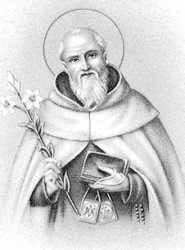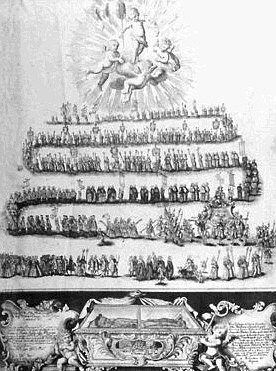Saint Simon Stock
![]()
Feast Day: May16th

Saint Simon Stock
![]()
Profile
Saint Simon Stock was born of one of the most illustrious Christian families of England, at the castle of Harford in 1164. Certain prodigies marked him, while an infant in the cradle, as a soul chosen by the Mother of God for Her own. Not yet one year old, he was heard to say the Angelic Salutation distinctly, before he had reached the age to learn it. As soon as he could read he began to recite the Little Office of the Blessed Virgin, and he would never cease to do so daily. He read Holy Scripture on his knees at the age of six. He became the object of the jealous persecution of one of his brothers, and at the age of twelve determined to leave and go to live in a forest.
He found a very large hollow tree, which became his oratory; and there Simon Stock lived like an angel of the desert. There he triumphed over the demon, as he would later tell his religious, only by the assistance of the Most Holy Virgin. When, deprived in his retreat of the Sacraments, he suffered sharp remorse and fear of his danger amid demoniac visions of criminal pleasures; Mary showed him the wiles of his enemy’s intentions in these harassments.
After twenty years he returned to his parents and resumed his studies, in particular those of theology. He was ordained a priest to obey the orders of Heaven, and then went back to his retreat, which he left definitively in the year 1212.
Amid the many persecutions raised against the Order of Mount Carmel, newly arrived in Europe, Saint Simon Stock, General of the Order, turned with filial confidence to the Blessed Mother of God. As he knelt in prayer on July 16, 1251, in the White Friars’ convent at Cambridge, She appeared before him and presented him with the well-known Brown Scapular, a loose sleeveless garment destined for the Order of Carmel, reaching from the shoulders to the knees. It was given as an assurance, for all who died wearing it, of Her heavenly protection from eternal death. An extraordinary promise indeed, but one requiring a life of prayer and sacrifice.
The incentive for his departure was a revelation the Blessed Mother made to him that the Carmelite Fathers of Palestine would come to found monasteries in England. When two Carmelite monks arrived in the company of two English lords returning from a crusade, he hastened to join them, but troubles prevented the foundation of their projected monastery. The three hermits therefore lived in cells near Oxford. The University of Oxford, by recourse to obedience, prevailed upon Simon’s Superiors to allow him to teach theology there, but he did not remain for long.
During a time of difficulty for England which resulted from the Britannic king’s conflicts with the Pope, he composed the famous hymn, Alma Redemptoris Mater, in honor of the Mother of God, to ask for the king’s conversion; his prayers were heard and suddenly the prince accepted all conditions of peace which a papal legate proposed. Saint Simon was soon made Vicar General of his Order for all of Europe. But opposition to the spread of the ancient Order of the Virgin was raised up by the enemy of souls, until Pope Honorius III put an end to it by bulls approving, confirming and protecting the Order from its enemies. He did so, he said, to conform to a command of the Mother of God Herself.
When a General Chapter of the Order was assembled on Mount Carmel itself, Saint Simon attended it. The question of the flight of the monks from the persecutions of the infidels was debated; Saint Simon won out over another opinion by saying that it was a great evil to expose one’s faith to the dangers of persecution without a specific order from heaven, according to the Gospel: “When you are persecuted in one city, flee to another.” The Order had already lost many of its houses, burnt and desecrated. So the monks dispersed to join an army of Crusaders, not without suffering the loss of the lives of several among them at the hands of the infidels. The Christian army, however, found its waters were poisoned by the hand of its enemies, and retired with Saint Simon and his religious to the Mountain of Carmel once again; there the ancient fountain of Elias gave water in abundance, in answer to their prayers. For six years Saint Simon remained on Carmel before returning to Aylesford in England.
The Order afterwards multiplied its foundations, making several in France, under its pious king Saint Louis IX. So prodigiously did it multiply under Saint Simon that a few years after his death, towards the end of the 13th century, it numbered, according to William of Tyre, several thousand monasteries or solitudes, which the same author estimated were peopled with some 125,000 religious. Saint Simon visited many of them in his extreme old age; he died at Bordeaux during his journeys in 1265.
![]()
Prayer to Simon Stock
Father, you called St Simon Stock to serve you in the brotherhood of Our Lady of Mount Carmel. Through his prayers help us like him to live in your presence and to work for the salvation of the human family. We ask this through Christ our Lord. Amen
![]()
Feast Day: March 24th

The Torture and Death of Saint Simon of Trent
Profile
The small Simon, a little boy from Trent, was slayed on the 21st March, 1475 A.D., on Maundy-Thursday during Holy Week. Some of the Jews of this town wanted to celebrate their Passover in their own way (Note: Not all Jews of these times, had a hatred for Catholics, and furthermore, this unfortunate event should not be a reason to have harsh feelings towards the Jewish community, instead we should do what Saint Simon would want us to do- pray for their conversion to the one true church started by Jesus Christ- the Holy Catholic Church) ; so they secretly abducted the small boy and carried him to the house of the Jew; Samuel. During Holy Week on Maundy-Thursday, the day before Good Friday, and on the day before the "Passover", about three hours after supper, the little boy, like children do, was sitting in front of his parents’ house. Neither his father nor mother were home at the time as they were at Church. It was at this time that the Jew Tobias approached the child, who was not quite 30 months old, and while speaking kindly and offering the boy a piece of money, picked him up and carried him at once to the house of the Jew Samuel.
When night fell, the twin brothers Saligman and Samuel, with Tobias, Vitalis (Veitel), Moses, Israel and Mayr, undressed the little boy and unmercifully butchered him. While Moses strangled him with a handkerchief as he lay across Samuel’s knee, pieces of flesh from his neck were cut with a knife and the blood collected in a bowl. At the same time, they punctured the naked offering with needles and murmured Hebrew curses. They then cut pieces of flesh from the boy’s arm and legs and collected the blood in pots.
Finally the torturers imitated the crucifixion by holding the twitching body upside down and the arms outstretched and during this horrible act they spoke the following:
"Take this, crucified Jesus. Just as our forefathers did once, so may all Christians by land and sea perish."
They then rushed to their meal. When the child had died they threw his body in the river which flowed by their house. After this, they joyously celebrated Passover. The case was prosecuted by Bishop Hinderbach, and the Jews were sentenced to death. Immediately, all Jews of the area protested the sentence and succeeded in gaining a new trial for the accused. It was tried before Giudici of Ventimiglia, and he confirmed the sentence. Again because of Jewish protests, the case came before the court of Pope Sixtus IV. He commissioned the greatest and most famous professor of law at that time, Panvino, to serve as Chief Justice. Assisted by six cardinals, he too confirmed the sentence.
The court officially
stated:
|
The records of this trial were originally kept in the secret archive of the Citadel of St. Angelo and were then transferred to the Vatican, where they are now available for examination. They were disclosed by Pope Benedict XIV. Also Pope Clement XIV as legal counsellor for the Holy Office, before he became Pope, verified the murders of both St. Simon of Trent, St. Andreas of Rinn and St. Dominguito del Val, Mártir as cases of ritual murder almost 300 years later after Simon's death, in 1770. The boy [Simon] who was tortured to death at Trent was officially canonized by Pope Sixtus V. The Holy Infant Martyr, St. Simon of Trent's feast day is always celebrated on March 24th. In these times you could only be a saint if you had several miracles, and God blessed Saint Simon of Trent with several hundred documented miracles from this child saints intercession, only in recent times have they tried to dismiss the sainthood of Saint Simon, because it does not fit well with the agenda of the present day Vatican officials, which is ecumenism. The cult was attempted to be "suppressed" (which is an impossibility). It is now said that the Jewish men that took part in this evil crime were in fact tortured to confess because of anti-Semitism. This is a lie that should not be entertained- Holy Mother Church was not mistaken or Pope Pius V by accepting Simon of Trent as a Saint of the Church. There are numerous cases of blood ritual reported in the past centuries. Many have been investigated by the Catholic Church and were confirmed, some by popes who had been unbelieving.
Born: 1472
Died: March 21, 1475
Beatified: 1588 by Pope Pius V
Canonized: 1588 by Pope Pius V
Patronage: Children, kidnap victims, libel, murder, anti-Semitism
